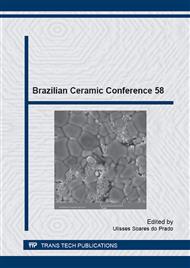p.161
p.167
p.172
p.181
p.187
p.193
p.199
p.205
p.213
Dielectric Characterization at High Temperature of Iron Doped Potassium Strontium Niobate Ceramic by Impedance Spectroscopy
Abstract:
Tetragonal Tungsten Bronze structure TTB-type structure has attracted interest by the high anisotropy of the crystal structure. The dielectric characterization of iron-doped niobate of TTB-type structure, with stoichiometry KSr2(Fe0.25Nb4.75)O15-δ, prepared by Modified Polyol Method was investigated. Nanocrystalline single phase powders were obtained after calcination of the precursor powder at 1150 °C for 10 hours in an oxygen atmosphere. The dielectric characterization was performed by impedance spectroscopy, from room temperature to 600 °C, in the frequency range of 5 Hz to 13 MHz. The permittivity values obtained for KSr2(Fe0.25Nb4.75)O15-δ showed superior to the permittivity values of the KSr2Nb5O15 host structure in all temperature range investigated. At room temperature, the permittivity values (2100) of KSr2(Fe0.25Nb4.75)O15-δ is two times the permittivity values of KSr2Nb5O15. The substitution of niobium cation by iron cation in the KSr2Nb5O15 host structure showed a suppression of the ferroelectric (P4bm) → paraelectric (P4/mbm) phase transition.
Info:
Periodical:
Pages:
187-192
Citation:
Online since:
June 2015
Price:
Сopyright:
© 2015 Trans Tech Publications Ltd. All Rights Reserved
Share:
Citation:


